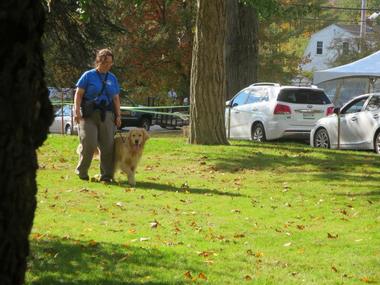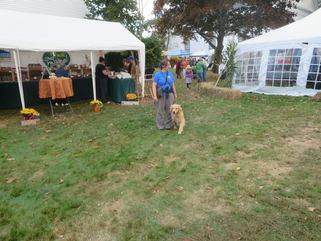 Walking with Boone to the Marketfest in York Maine.
Walking with Boone to the Marketfest in York Maine.  Boone is happy cooperating here. We have worked together a lot by this point, and we are on an adventure together.
Boone is happy cooperating here. We have worked together a lot by this point, and we are on an adventure together. Loose leash walking is a very important skill for a dog to have. It allows the dog to go to more places outside of the home, and makes the walks enjoyable to BOTH the owner and the dog. It builds confidence and impulse control, which you will appreciate even more so if you have a reactive dog.
Trust me, the dog is not comfortable pulling or lunging against their collar. That is one of the reasons that we teach a loose leash (the other is it is not too comfortable for their humans either). Dogs in general are much happier when the owner is not frustrated with them as well. By teaching this to your dog, you are only going to improve their life as well as your enjoyment of bringing them out with you.
As for methods (or parts of methods, as a method is the whole process of teaching obedience via a plan) there are many:
- There is the old stand like a tree when your dog hits the end of the leash. Most dogs need a little more than this when they get older. I find it useful for very young puppies to get started on this (among other ways).
- There is the Mike Ellis type method for which will rely on your building a relationship based on engagement for you and your dog. I have used this with my dogs, but not as the only method yet.
- There is the long line method that I use for dogs six months and older that is based off the beginning of the Koehler method. Of course the use for this is to build whole obedience skills with this as simply the start. Generally, I find this a great way of laying a foundation not only for obedience but impulse control as well.
- Personally, I like to train a formal heel and then loosen that up at a later date. I find (for me) that makes the process a lot less frustrating and ultimately faster. Plus, I use heel quite a bit anyway. I do start heel with the long line above.
The things to think about when choosing a method are the following:
- What are your specific goals? Different owners have different goals that could effect the method of training preferred (for example they may later want to work in agility, free style dancing, or maybe they just want a nice family pet).
- What is the temperament of your dog and are you having any other problems that you need to address? Sometimes you can take your time training your dog, and other times other factors may make training an immediate safety need. You also may need to take current behavioral problems into consideration.
- How old is your dog or puppy? Adult dogs and puppies younger than six months old are generally trained in a different way with different expectations. Young puppies are not mature enough yet to give the same performance or perform to expectations of a mature older adult.
- What is your dog mellow, hyper, or fearful? This may also effect the method you wish to adopt going forward.
- Who else regularly interacts with your dogs and do they have any special needs?
- What is the dog owner's health and activity level like? There are some training methods that require more physically of the dog owner than others, especially in the first few weeks or months.
The final outcome of loose leash walking should look something like this:)
 RSS Feed
RSS Feed